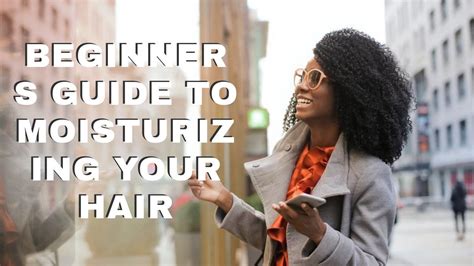Introduction
Healthy, lustrous hair requires adequate moisture to maintain its strength, elasticity, and shine. Neglecting hydration can lead to dryness, breakage, and a dull appearance. This comprehensive guide will delve into the intricate world of hair moisturizing, providing you with a wealth of knowledge and practical tips to achieve hydrated and vibrant locks.

The Importance of Hair Moisture
- Strength and Elasticity: Moisture helps strengthen the hair shaft, preventing breakage and split ends.
- Flexibility and Definition: Hydrated hair is more pliable, allowing it to curl and style easily.
- Shine and Glossiness: Water molecules in the hair shaft reflect light, creating a glossy and radiant appearance.
- Protection from Environmental Damage: Moisture acts as a barrier against external aggressors such as heat, UV radiation, and pollution.
Factors that Deplete Hair Moisture
Understanding the factors that lead to hair moisture loss is crucial for effective hydration strategies.
- Chemical Treatments: Hair dyes, perms, and relaxers can strip away natural oils and moisture.
- Heat Styling: Excessive use of blow dryers, flat irons, and curling irons can evaporate moisture from the hair.
- Environmental Factors: Sun exposure, wind, and low humidity can dehydrate hair.
- Over-washing: Shampooing too frequently can remove essential oils and disrupt the hair’s natural moisture balance.
- Health Conditions: Certain medical conditions, such as hypothyroidism and diabetes, can affect hair growth and hydration.
The Science Behind Hair Moisturizing
The hair shaft is primarily composed of a protein called keratin. When keratin is adequately hydrated, it forms hydrogen bonds with water molecules, creating a strong and flexible structure. However, when the hair is dry, these bonds weaken, leading to diminished strength and elasticity.
Effective Hair Moisturizing Strategies
-
Shampoo and Conditioner:
– Use gentle shampoos that cleanse without stripping away natural oils.
– Opt for conditioners designed to hydrate and repair dry hair. -
Leave-in Treatments:
– Apply leave-in conditioners or deep conditioners regularly to seal in moisture and prevent evaporation.
– Consider using products containing humectants like glycerin and hyaluronic acid. -
Hair Oils:
– Natural oils, such as coconut oil, argan oil, and jojoba oil, provide deep nourishment and protect hair from moisture loss.
– Apply oils to the ends of your hair or as a pre-shampoo treatment. -
Hydrating Masks:
– Use hair masks specifically formulated to moisturize and replenish dry hair.
– Look for masks containing ingredients like avocado, honey, or aloe vera. -
Protective Styling:
– Avoid tight hairstyles that put stress on the hair and break off strands.
– Consider using silk pillowcases to reduce friction and prevent moisture loss during sleep.
Tips and Tricks for Moisturized Hair
- Avoid excessive heat styling.
- Limit the use of chemical treatments.
- Protect your hair from the sun and wind.
- Trim split ends regularly.
- Follow a healthy diet rich in vitamins and minerals that support hair health.
- Stay hydrated by drinking plenty of water.
- Consider using a humidifier in your home to increase air moisture.
Common Mistakes to Avoid
- Over-washing: Shampooing too frequently can strip away natural oils and dehydrate hair.
- Skipping conditioner: Conditioner is essential for replenishing moisture and protecting hair from damage.
- Using harsh products: Avoid shampoos and conditioners that contain sulfates or harsh chemicals.
- Ignoring the ends: The ends of the hair are the most susceptible to dryness. Focus on applying moisturizing products to them.
- Brushing wet hair: Brushing wet hair can cause breakage. Wait until it is dry or use a detangling spray.
FAQs
-
How often should I wash my hair?
– The frequency of washing depends on hair type and texture. Aim for washing every 2-3 days for normal hair and less frequently for dry hair. -
What ingredients should I look for in hair moisturizers?
– Humectants (glycerin, hyaluronic acid), emollients (natural oils), and occlusives (beeswax, mineral oil) are key ingredients for hair moisture. -
How can I protect my hair from heat damage?
– Use a heat protectant spray before styling with hot tools.
– Limit the time spent using high heat and use lower temperature settings. -
Is it necessary to trim split ends?
– Yes, trimming split ends prevents further damage and promotes healthy hair growth. Aim to trim every 6-8 weeks. -
How long does it take to see results from hair moisturizing?
– Results vary depending on hair type and damage level. However, with consistent use of moisturizing products, you should notice a gradual improvement in hair texture, shine, and strength. -
Can I use oil-based moisturizers on oily hair?
– Lightweight oil-based moisturizers can be used on oily hair to combat dryness and balance oil production. Focus on applying them sparingly to the ends.
Conclusion
Maintaining hair moisture is paramount for achieving healthy, radiant, and manageable locks. By understanding the importance of hydration and employing effective moisturizing strategies, you can restore and preserve your hair’s natural beauty. Remember, consistency and patience are key in achieving long-lasting results.
